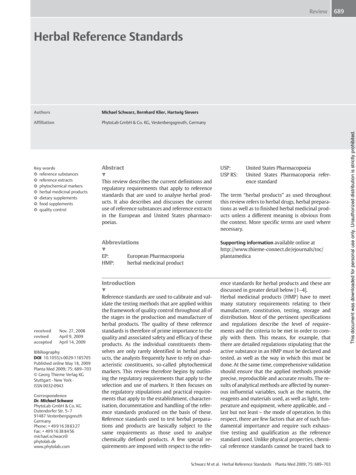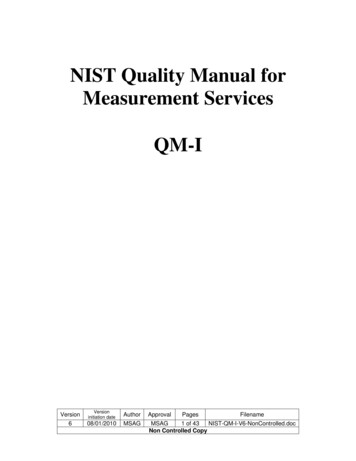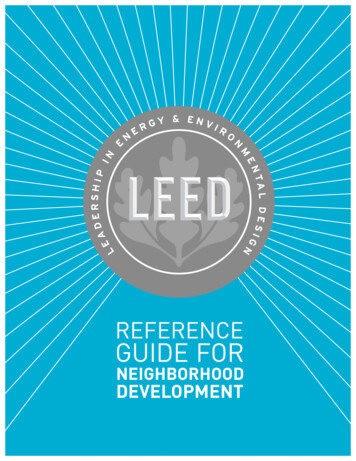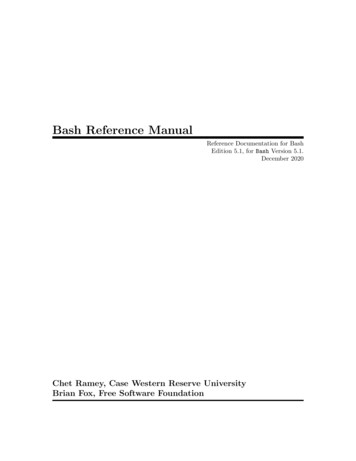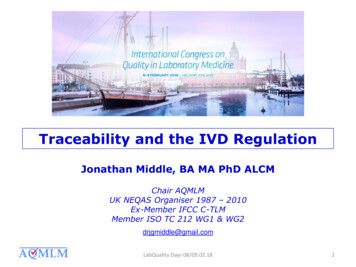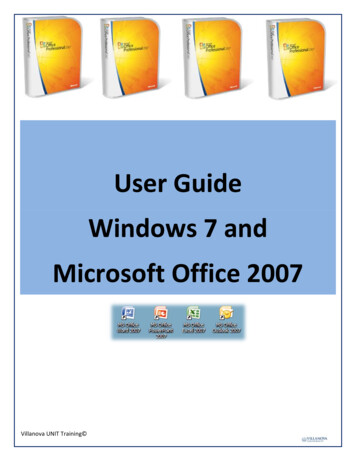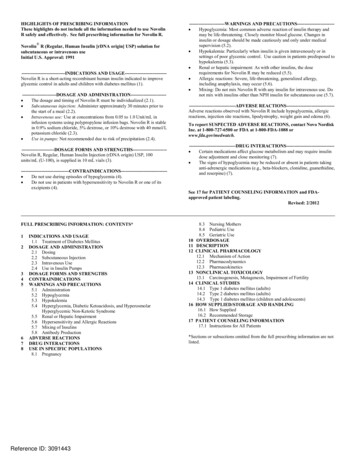
Transcription
HIGHLIGHTS OF PRESCRIBING INFORMATIONThese highlights do not include all the information needed to use NovolinR safely and effectively. See full prescribing information for Novolin R. Novolin R (Regular, Human Insulin [rDNA origin] USP) solution forsubcutaneous or intravenous useInitial U.S. Approval: 1991----------------------------INDICATIONS AND USAGE--------------------------Novolin R is a short-acting recombinant human insulin indicated to improveglycemic control in adults and children with diabetes mellitus (1).----------------------DOSAGE AND ADMINISTRATION---------------------- The dosage and timing of Novolin R must be individualized (2.1). Subcutaneous injection: Administer approximately 30 minutes prior tothe start of a meal (2.2). Intravenous use: Use at concentrations from 0.05 to 1.0 Unit/mL ininfusion systems using polypropylene infusion bags. Novolin R is stablein 0.9% sodium chloride, 5% dextrose, or 10% dextrose with 40 mmol/Lpotassium chloride (2.3). Use in pumps: Not recommended due to risk of precipitation (2.4).---------------------DOSAGE FORMS AND STRENGTHS---------------------Novolin R, Regular, Human Insulin Injection (rDNA origin) USP, 100units/mL (U-100), is supplied in 10 mL vials NS----------------------------- Do not use during episodes of hypoglycemia (4). Do not use in patients with hypersensitivity to Novolin R or one of itsexcipients (4).-----------------------WARNINGS AND PRECAUTIONS----------------------- Hypoglycemia: Most common adverse reaction of insulin therapy andmay be life-threatening. Closely monitor blood glucose. Changes ininsulin or dosage should be made cautiously and only under medicalsupervision (5.2). Hypokalemia: Particularly when insulin is given intravenously or insettings of poor glycemic control. Use caution in patients predisposed tohypokalemia (5.3). Renal or hepatic impairment: As with other insulins, the doserequirements for Novolin R may be reduced (5.5). Allergic reactions: Severe, life-threatening, generalized allergy,including anaphylaxis, may occur (5.6). Mixing: Do not mix Novolin R with any insulin for intravenous use. Donot mix with insulins other than NPH insulin for subcutaneous use (5.7).------------------------------ADVERSE REACTIONS------------------------------Adverse reactions observed with Novolin R include hypoglycemia, allergicreactions, injection site reactions, lipodystrophy, weight gain and edema (6).To report SUSPECTED ADVERSE REACTIONS, contact Novo NordiskInc. at 1-800-727-6500 or FDA at 1-800-FDA-1088 ---DRUG INTERACTIONS------------------------------ Certain medications affect glucose metabolism and may require insulindose adjustment and close monitoring (7). The signs of hypoglycemia may be reduced or absent in patients takinganti-adrenergic medications (e.g., beta-blockers, clonidine, guanethidine,and reserpine) (7).See 17 for PATIENT COUNSELING INFORMATION and FDAapproved patient labeling.Revised: 2/2012FULL PRESCRIBING INFORMATION: CONTENTS*12345678INDICATIONS AND USAGE1.1 Treatment of Diabetes MellitusDOSAGE AND ADMINISTRATION2.1 Dosing2.2 Subcutaneous Injection2.3 Intravenous Use2.4 Use in Insulin PumpsDOSAGE FORMS AND STRENGTHSCONTRAINDICATIONSWARNINGS AND PRECAUTIONS5.1 Administration5.2 Hypoglycemia5.3 Hypokalemia5.4 Hyperglycemia, Diabetic Ketoacidosis, and HyperosmolarHyperglycemic Non-Ketotic Syndrome5.5 Renal or Hepatic Impairment5.6 Hypersensitivity and Allergic Reactions5.7 Mixing of Insulins5.8 Antibody ProductionADVERSE REACTIONSDRUG INTERACTIONSUSE IN SPECIFIC POPULATIONS8.1 PregnancyReference ID: 3091443101112131416178.3 Nursing Mothers8.4 Pediatric Use8.5 Geriatric UseOVERDOSAGEDESCRIPTIONCLINICAL PHARMACOLOGY12.1 Mechanism of Action12.2 Pharmacodynamics12.3 PharmacokineticsNONCLINICAL TOXICOLOGY13.1 Carcinogenesis, Mutagenesis, Impairment of FertilityCLINICAL STUDIES14.1 Type 1 diabetes mellitus (adults)14.2 Type 2 diabetes mellitus (adults)14.3 Type 1 diabetes mellitus (children and adolescents)HOW SUPPLIED/STORAGE AND HANDLING16.1 How Supplied16.2 Recommended StoragePATIENT COUNSELING INFORMATION17.1 Instructions for All Patients*Sections or subsections omitted from the full prescribing information are notlisted.
FULL PRESCRIBING INFORMATION1INDICATIONS AND USAGE1.1Treatment of Diabetes MellitusNovolin R is indicated to improve glycemic control in adults and children with diabetes mellitus.2DOSAGE AND ADMINISTRATION2.1DosingThe dosage and timing of Novolin R must be individualized. Blood glucose monitoring isessential for all patients receiving insulin therapy.Total daily insulin requirements vary and are usually between 0.5 and 1.0 units/kg/day. Insulinrequirements may be altered during stress, major illness, or with changes in exercise, meal patterns, orcoadministered medications.2.2Subcutaneous InjectionNovolin R should generally be injected approximately 30 minutes prior to the start of a meal.Novolin R given by subcutaneous injection should generally be used in regimens that include anintermediate or long-acting insulin [see How Supplied/Storage and Handling (16.1, 16.2)].Novolin R should be administered by subcutaneous injection in the abdominal region, buttocks,thigh, or the upper arm. Subcutaneous injection into the abdominal wall is generally associated withfaster absorption than other injection sites. Injection sites should be rotated within the same region toreduce the risk of lipodystrophy. Injection into a lifted skin fold minimizes the risk of intramuscularinjection.2.3Intravenous UseNovolin R can be administered intravenously under medical supervision for glycemic control,with close monitoring of blood glucose and potassium concentrations to avoid hypoglycemia andhypokalemia [see Warnings and Precautions (5.2, 5.3), How Supplied/Storage and Handling (16.1,16.2)].Intravenous administration of insulin is commonly used in the treatment of diabetic ketoacidosis,peri-operative management of diabetes, and maintenance of glycemic control during labor in pregnantdiabetic women. For intravenous use, Novolin R should be used at concentrations from 0.05 units/mL to1.0 unit/mL in infusion systems using polypropylene infusion bags. Novolin R can be used with thefollowing infusion fluids: 0.9% sodium chloride, 5% dextrose, or 10% dextrose with 40 mmol/Lpotassium chloride.Parenteral drug products should be inspected visually for particulate matter and discolorationprior to administration, whenever solution and container permit. Never use Novolin R if it has becomeviscous or cloudy; use Novolin R only if it is clear and colorless. Vials should not be used if leakage isobserved. Novolin R should not be used after the printed expiration date.The onset of action of Novolin R, when administered intravenously, is more rapid in comparisonto subcutaneous administration.Reference ID: 3091443
2.4Use in Insulin PumpsUse of Novolin R in insulin pumps is not recommended because of the risk of precipitation.3DOSAGE FORMS AND STRENGTHS 4Novolin R is available in 10 mL vials. The concentration of Novolin R is 100 USP units of humaninsulin (rDNA origin)/mL.CONTRAINDICATIONSNovolin R is contraindicated: During episodes of hypoglycemia In patients with hypersensitivity to Novolin R or one of its excipients5WARNINGS AND PRECAUTIONS5.1AdministrationSubcutaneous injection of Novolin R should be followed by a meal. Patients should waitapproximately 30 minutes after injection before starting the meal [see Dosage and Administration (2.2)].Any change of insulin dose should be made cautiously and only under medical supervision.Changing from one insulin product to another or changing the insulin strength may result in the need fora change in dosage. As with all insulin preparations, the time course of Novolin R action may vary indifferent individuals or at different times in the same individual and is dependent on many conditions,including dosage, the site of injection, local blood supply, temperature, and physical activity. Patientswho change their level of physical activity or meal plan may require adjustment of insulin dosages.Insulin requirements may be altered during illness, emotional disturbances, or other stresses.5.2HypoglycemiaHypoglycemia is the most common adverse reaction of all insulin therapies, including NovolinR. Severe hypoglycemia may lead to unconsciousness, convulsions, temporary or permanentimpairment of brain function or death. Severe hypoglycemia requiring the assistance of another person,parenteral glucose infusion, and glucagon administration has been observed in clinical trials withinsulin, including trials with Novolin R.The timing of hypoglycemia usually reflects the time-action profile of the administered insulinformulations [see Clinical Pharmacology (12.2, 12.3)]. Other factors such as changes in food intake(e.g., amount of food or timing of meals), injection site, exercise, and concomitant medications may alsoalter the risk of hypoglycemia [see Drug Interactions (7)]. As with all insulins, use caution in patientswith hypoglycemia unawareness and in patients who may be predisposed to hypoglycemia (e.g., patientswho are fasting or have erratic food intake, pediatric patients, and the elderly). The patient’s ability toconcentrate and react may be impaired as a result of hypoglycemia. This may present a risk in situationswhere these abilities are especially important, such as driving or operating other machinery.Rapid changes in serum glucose concentrations may induce symptoms of hypoglycemia inpatients with diabetes, regardless of the glucose value. Early warning symptoms of hypoglycemia maybe different or less pronounced under certain conditions, such as longstanding diabetes, diabeticneuropathy, use of medications such as beta-blockers, or intensified glycemic control [see DrugInteractions (7)]. These situations may result in severe hypoglycemia (and, possibly, loss ofconsciousness) prior to the patient’s awareness of hypoglycemia. Intravenously administered insulin hasReference ID: 3091443
a more rapid onset of action than subcutaneously administered insulin, requiring more close monitoringfor hypoglycemia.5.3HypokalemiaAll insulins, including Novolin R, cause a shift in potassium from the extracellular tointracellular space, possibly leading to hypokalemia that, if left untreated, may cause respiratoryparalysis, ventricular arrhythmia, and death. Use caution in patients who may be at risk for hypokalemia(e.g., patients using potassium-lowering medications and patients taking medications sensitive to serumpotassium concentrations). Monitor glucose and potassium frequently when Novolin R is administeredintravenously.5.4Hyperglycemia, Diabetic Ketoacidosis, and Hyperosmolar Hyperglycemic Non-KetoticSyndromeHyperglycemia, diabetic ketoacidosis, or hyperosmolar hyperglycemic non-ketotic syndromemay develop in patients who take less insulin than needed to control blood glucose. These conditionscan be precipitated by illness, infection, dietary indiscretion, or omission or improper administration ofthe prescribed insulin dose.5.5Renal or Hepatic ImpairmentAs with other insulins, the dose requirements for Novolin R may be reduced in patients withrenal or hepatic impairment.5.6Hypersensitivity and Allergic ReactionsLocal Reactions - As with other insulins, patients may experience redness, swelling, or itching atthe site of injection of Novolin R. These reactions usually resolve in a few days to a few weeks, but insome occasions, may require discontinuation of Novolin R. In some instances, these reactions may berelated to factors other than insulin, such as irritants in a skin cleansing agent or poor injectiontechnique. Localized reactions and generalized myalgias have been reported with the use of meta cresol, which is an excipient in Novolin R.Systemic Reactions - Severe, life-threatening, generalized allergy, including anaphylaxis mayoccur with any insulin, including Novolin R. Generalized allergy to insulin may manifest as a wholebody rash (including pruritus), dyspnea, wheezing, hypotension, tachycardia, or diaphoresis.5.7Mixing of InsulinsIf Novolin R is mixed with NPH human insulin, Novolin R should be drawn into the syringe firstand the mixture should be injected immediately after mixing. Insulin mixtures should not beadministered intravenously.5.8Antibody ProductionIncreases in titers of anti-insulin antibodies that react with human insulin have been observed inpatients treated with Novolin R. Data from a 12-month controlled trial in patients with type 1 diabetessuggest that the increase in these antibodies is transient. The clinical significance of these antibodies isnot known but does not appear to cause deterioration in glycemic control or necessitate increases ininsulin dose.Reference ID: 3091443
6ADVERSE REACTIONS HypoglycemiaHypoglycemia is the most commonly observed adverse reaction in patients using insulin, includingNovolin R [see Warnings and Precautions (5.2)]. Insulin initiation and glucose control intensificationIntensification or rapid improvement in glucose control has been associated with a transitory,reversible ophthalmologic refraction disorder, worsening of diabetic retinopathy, and acute painfulperipheral neuropathy. Over the long-term, improved glycemic control decreases the risk ofdiabetic retinopathy and neuropathy. LipodystrophyLong-term use of insulin, including Novolin R, can cause lipodystrophy at the site of repeatedinsulin injections. Lipodystrophy includes lipohypertrophy (thickening of adipose tissue) andlipoatrophy (thinning of adipose tissue), and may affect insulin absorption. Rotate insulin injectionsites within the same region to reduce the risk of lipodystrophy. Weight gainWeight gain can occur with insulin therapies, including Novolin R, and has been attributed to theanabolic effects of insulin and the decrease in glucosuria. Peripheral edemaInsulin may cause s
8.3 Nursing Mothers . 8.4 Pediatric Use . 1 INDICATIONS AND USAGE . 8.5 . Geriatric Use . 10 OVERDOSAGE 2 DOSAGE AND ADMINISTRATION . 1.1 Treatment of Diabetes Mellitus . 11 DESCRIPTION . 2.1 Dosing . 12 CLINICAL PHARMACOLOGY . 2.2 Subcutaneous Injection . 12.1 Mechanism of Action 2.3 Intravenous Use 12.2 Pharmacodynamics 2.4 Use in Insulin Pumps


